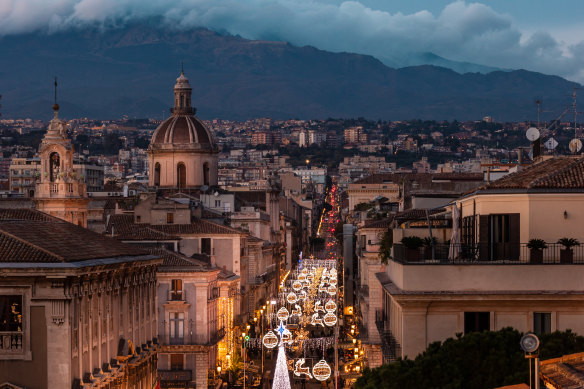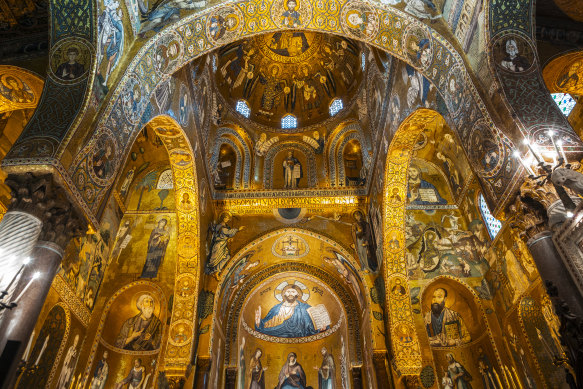This was published 1 year ago
There is a fresh discovery around every corner on the enchanting island of Sicily
By Ute Junker
You never forget your first sight of the town of Modica. Glance down as you drive over the Guerrieri Bridge in southern Sicily, suspended 300 metres above a deep gorge, and there you will see the town, its houses appearing to tumble vertiginously down the steep sides of the gorge.

The ancient port city of Catania.Credit: Getty Images
A walk through Modica’s slanting streets, many of them linked by staircases, is worth the strain on your knees. This compact town has a long history – people found shelter in caves near the top of the gorge as early as the 15th century BC – and also a mighty one, as the headquarters of counts who, for 500 years, were among the most powerful rulers in Sicily.
Modica has also seen dark days. In 1693, a massive earthquake destroyed much of south-eastern Sicily, including Modica. The town was rebuilt in an eye-catching contemporary style now known as Sicilian baroque. Intricately decorated with columns and balconies, cherubs and carved stone masks, Modica’s grand architecture has been recognised with a UNESCO World Heritage designation, alongside seven other towns in the Val di Noto region.
Each of these towns is a destination in its own right. Among them are Noto, blessed with grand portals and ornate churches; Sicily’s second-largest city, Catania, where many faÇades are covered with black-lava stone created by past explosions of Mount Etna; and Caltagirone, where staircases and faÇades are decorated with the area’s distinctive majolica enamelled ceramics.
These beautiful baroque towns are just one of Sicily’s many attractions. The island may be compact, around one-third the size of Tasmania, but it has no fewer than seven World Heritage listings, with something to appeal to every sort of traveller.
Love ancient history? The Valley of the Temples near Agrigento contains some of the best-preserved Greek temples in the world, while Villa Romana del Casale – built as the residence of an entrepreneur who supplied wild animals for the gladiatorial combats beloved in ancient Rome – is bedecked with an astonishing 3500 square metres of beautifully preserved mosaics, including vivid depictions of hunters capturing African beasts for the arena.
There is the picturesque island of Ortigia, part of the ancient city of Syracuse, where Greek, Roman and Baroque influences blend into an irresistible confection. (The baroque Norman cathedral, built around the remains of an ancient Greek temple, is particularly eye-catching.)
If you lean more towards the great outdoors, you can’t go past Mount Etna, the snow-capped active volcano that is almost a world unto itself. Soaring 3350 metres, its landscapes range from forests to lava fields and vineyards that produce some stellar wines.
Etna is Sicily’s most famous volcano but it has company. Just 30 kilometres off Sicily’s northern coast, the Aeolian archipelago – yet another World Heritage site – is home to another two active volcanoes, Stromboli and Vulcano, as well as beautiful beaches washed by crystal-clear waters.
Sicily’s seventh World Heritage listing is shared between its largest city, Palermo, and the nearby churches of Cefalù and Monreale, and celebrates the distinctive Arab-Norman architecture of 1000 years ago. It’s hard to resist the Byzantine mosaics seen at their glittering best in the church of Monreale and the Palatine Chapel in Palermo.

Palatine Chapel in Palermo.Credit: Getty Images
Palermo is also home to yet another Sicilian wonder that doesn’t have a World Heritage listing but deserves more recognition than it gets: the island’s distinctive cuisine. A melange of all the cultures that have settled here, from the Greeks to the Arabs to the Spaniards, its signature ingredients include everything from couscous to sesame seeds, eggplants to olives.
Palermo’s street food is in a class of its own: for every familiar dish such as arancini, there is something unusual such as sfincione, a pizza-like focaccia. On a hot day, cool down with an icy granita or a glass of pomegranate juice, pressed fresh by a street vendor.
The seafood is, of course, superb (the fish market in Catania is worth a visit), but perhaps the island’s most notable contribution to Italian cuisine is its extraordinary pastries. Sicily is not only the birthplace of the much-loved cannoli but also the Genovese, filled with ricotta or custard cream, the almond-flavoured ciarduna and the doughnut-like sfinci, topped with candied fruit.
Make the most of your health, relationships, fitness and nutrition with our Live Well newsletter. Get it in your inbox every Monday.